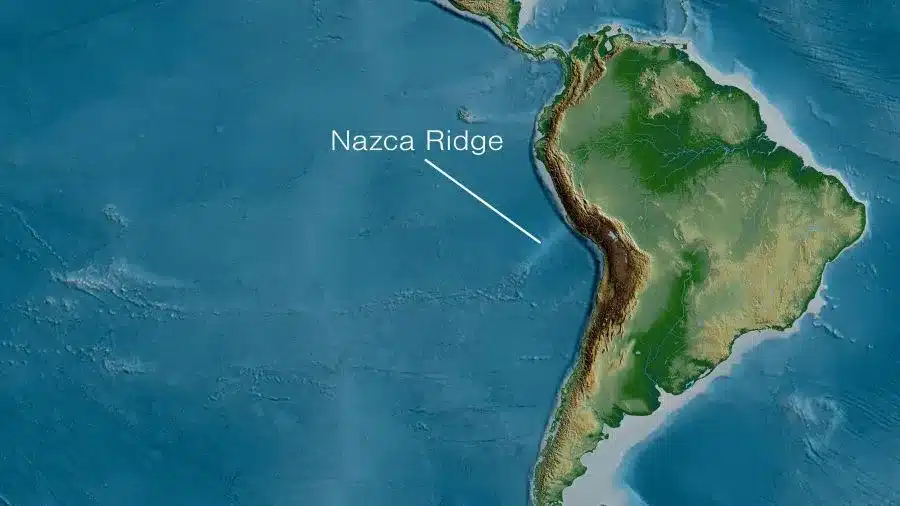About Nazca Ridge:
- It is a submarine ridge located in the southeastern Pacific Ocean off the coast of South America.
- It is approximately 1,100 kilometers (684 miles) long and varies in width.
- The ridge extends from the Nazca Plate, off the coast of Peru, and runs southwest toward Easter Island, Chile.
- It was formed by volcanic activity associated with a hotspot in the Earth’s mantle.
- The ridge is composed of abnormally thick basaltic ocean crust.
- The ridge is tectonically active and is being subducted beneath the South American Plate at the Peru-Chile Trench.
What is a Seamount?
- A seamount is an underwater mountain with steep sides rising from the seafloor.
- Most seamounts are remnants of extinct volcanoes.
- Typically, they are cone-shaped but often have other prominent features such as craters and linear ridges, and some, called guyots, have large, flat summits.
- There is a broad size distribution for seamounts, but to be classified as a seamount, the feature must have a vertical relief of at least 1,000 meters (3,300 feet) above the surrounding seafloor.
- Seamounts are found in every world ocean basin.
- These are formed near mid-ocean ridges, where the earth’s tectonic plates are moving apart, allowing molten rock to rise to the seafloor.
- Some seamounts have also been found near intraplate hotspots – regions of heavy volcanic activity within a plate – and oceanic island chains with a volcanic and seismic activity called island arcs.
Q1: What is ocean crust?
Oceanic crust, the outermost layer of Earth’s lithosphere that is found under the oceans and formed at spreading centres on oceanic ridges, which occur at divergent plate boundaries. Oceanic crust is about 6 km (4 miles) thick. It is composed of several layers, not including the overlying sediment. The topmost layer, about 500 metres (1,650 feet) thick, includes lavas made of basalt (that is, rock material consisting largely of plagioclase [feldspar] and pyroxene).
Source: Ocean World Exploration: A New Seamount And Previously Unknown Species Discovered
Last updated on January, 2026
→ Check out the latest UPSC Syllabus 2026 here.
→ Join Vajiram & Ravi’s Interview Guidance Programme for expert help to crack your final UPSC stage.
→ UPSC Mains Result 2025 is now out.
→ UPSC Notification 2026 is scheduled to be released on January 14, 2026.
→ UPSC Calendar 2026 has been released.
→ UPSC Prelims 2026 will be conducted on 24th May, 2026 & UPSC Mains 2026 will be conducted on 21st August 2026.
→ The UPSC Selection Process is of 3 stages-Prelims, Mains and Interview.
→ Prepare effectively with Vajiram & Ravi’s UPSC Prelims Test Series 2026 featuring full-length mock tests, detailed solutions, and performance analysis.
→ Enroll in Vajiram & Ravi’s UPSC Mains Test Series 2026 for structured answer writing practice, expert evaluation, and exam-oriented feedback.
→ Join Vajiram & Ravi’s Best UPSC Mentorship Program for personalized guidance, strategy planning, and one-to-one support from experienced mentors.
→ UPSC Result 2024 is released with latest UPSC Marksheet 2024. Check Now!
→ UPSC Toppers List 2024 is released now. Shakti Dubey is UPSC AIR 1 2024 Topper.
→ Also check Best UPSC Coaching in India

















